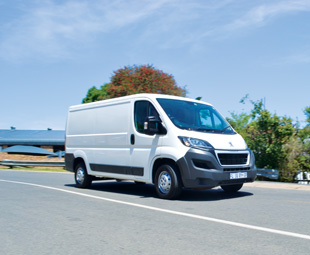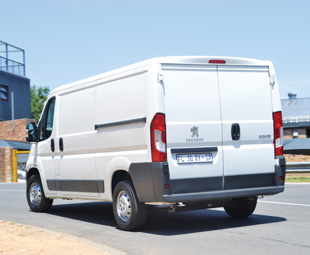Box of tricks

A rather voluminous van that requires only a code-B licence to drive, the Peugeot Boxer X250 L2H1 holds many charms, writes GAVIN MYERS
While the good-ol’ bakkie remains the light commercial vehicle (LCV) of choice for the South African consumer, an increasingly strong case is being made for the integral van – especially when the need to move volume is more important than shifting weight.
A plethora of models account for all needs; from the smallest offering half- or three-quarter-tonne payloads to larger models that offer up to 2,5-t carrying capacity, but require a higher category driving licence.
The Peugeot Boxer you see here sits somewhere in the middle – being the L2H1 model of the revised X250 range. It is rated at a gross vehicle mass (GVM) of 3 300 kg with a 1 400 kg payload. The gross combination mass (GCM) of this model is 5 800 kg. What is slightly more important when evaluating a panel van is the load volume, of which the L2H1 offers 10 m3.
This is accessed through 1 520-mm high x 1 562-mm wide rear doors that swing out to 180°, and a sliding left-hand side door with an aperture of 1 485 x 1 250 mm. These can be locked and unlocked independent of the cab from within the vehicle and from the remote key.
 For one of the smaller large vans on the market, the L2H1 offers a cargo area that measures 3 120-mm long,
For one of the smaller large vans on the market, the L2H1 offers a cargo area that measures 3 120-mm long,
1 662-mm high and 1 870-mm wide (1 422 mm between the wheel arches).
Powering the L2H1 is a 96 kW, 320 Nm four-cylinder turbodiesel of 2,2-litre capacity. It drives the front wheels through a six-speed manual gearbox that has a notchy shift action, but very well-spaced ratios.
This might be the smaller of the two engines offered in the Boxer X250 range, but it does pull like a train – smoothly too – in any gear from just 1 000 r/min (the torque peak sits at 2 000, and the delivery is sustained up to 4 000 r/min).
Peugeot claims that in an urban environment – where this vehicle is likely to spend most of its time – the L2H1 will consume 9,3 l/100 km, with 7,5 on the combined route. That’s not to say the Boxer can’t take to the highways – it’s actually a very competent, surprisingly refined cruiser.
The only gripe to be levelled – which applies to this class of vehicle as a whole – is the limited rearward visibility due to the narrow side windows. Large (manually adjustable) wing mirrors with secondary wide-angle mirrors (also adjustable) go some way to addressing this.
 Otherwise, driving the Boxer is a treat. Each of the three comfortable seats is full width – meaning the passengers have a large amount of shoulder room – and the driver’s seat is independently adjustable. While the airbag-equipped steering wheel is adjustable for height, some angle adjustment would round off an otherwise comfy driving position.
Otherwise, driving the Boxer is a treat. Each of the three comfortable seats is full width – meaning the passengers have a large amount of shoulder room – and the driver’s seat is independently adjustable. While the airbag-equipped steering wheel is adjustable for height, some angle adjustment would round off an otherwise comfy driving position.
There are several storage compartments within the cabin, including overhead and under-seat trays; two clipboards (neither is removable); a large, lockable document cubby and cooled dash-top cubby big enough for a bottle of water.
While the tinted windows help keep things cool, I was glad to see that the test unit was fitted with the optional air-conditioning. The optional Bluetooth-equipped radio and cruise control with speed limiter were not fitted, though. Anti-lock brakes with Emergency Brake Assist is standard, as is an electronic immobiliser.
Priced at R455 900, the Peugeot Boxer X250 L2H1 proves to be a very competent code-B workhorse, with huge space and capability. Aftersales backup is provided by a five-year/100 000 km service plan, three-year/100 000 km warranty; and five-year anti-perforation and three-year paint warranties. A full maintenance plan is optional.
Published by
Focus on Transport
focusmagsa




